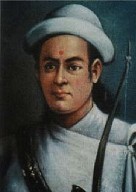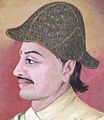Kunwar family
This article has multiple issues. Please help improve it or discuss these issues on the talk page. (Learn how and when to remove these template messages)
|
| Kunwar family कुँवर वंश/कुँवर खलक Kingdom of Gorkha | |
|---|---|
Jang Bahadur Kunwar Rana (Ramkrishna family) (Jayakrishna family)Balbhadra Kunwar | |
| Titles |
|
Style(s) |
|
| Estate(s) | Bhanwarkot and Dhulikhel |
| Dissolution | 15 May 1848 (conversion to Rana dynasty) |
| Cadet branches | Rana dynasty |
A section of Kunwars titled themselves as "Rana" onwards 1848 CE. | |
The Kunwar family (
Origins
Genealogy
The Kunwars of Nepal claim descent from a
John Whelpton opines that the legend of the Kunwar family's origins, which says their progenitor to have entered hill and married a daughter of Bagale Kshetri, might have linked their family to the Bagale Thapa, a clan of Mukhtiyar Bhimsen Thapa.[9]
Caste Background
This family was a minor section of the
Historicity

Ahiram (Ashiram) Kunwar was a nobleman of the Kingdom of Kaski. Later, he went to the
Ram Krishna family/Rana Kunwars

Ram Krishna had only one son named
Jaya Krishna family
Jaya Krishna Kunwar had a son named

In Nepal, the story of the battle at Nalapani has gained legendary status and has become an important part of the nation's historical narrative, while Balbhadra himself has become one of the
This is inscribed as a tribute of respect to our gallant adversary Bulbudder and his brave Goorkhas who were afterwards, while in the service of Runjitsingh, shot dead by the Afghan artillery to the last man.[3]
Kunwar family tree
| Ahirama Kunwar | |||||||||||||||||||||||||||||||||||||||||||||||||||
| Ram Krishna Kunwar | Jaya Krishna Kunwar | Amar Singh Kunwar | |||||||||||||||||||||||||||||||||||||||||||||||||
| Ranajit Kunwar | Chandrabir Kunwar | ||||||||||||||||||||||||||||||||||||||||||||||||||
| Bal Narsingh Kunwar | Balaram Kunwar | Rewant Kunwar | Bira Bhadra Kunwar | Balbhadra Kunwar | Chetan Singh Kamar | ||||||||||||||||||||||||||||||||||||||||||||||
Gallery
-
Balabhadra Kunwar, a Kunwar dynast on Jayakrishna branch
-
Bal Narsingh Kunwar, a Kunwar dynast on Ramkrishna branch
-
Bam Bahadur Kunwar, son of Bal Narsingh, later Prime Minister of Nepal
-
Ranodip Singh Kunwar, son of Bal Narsingh, later Prime Minister of Nepal and Maharaja of Lamjung and Kaski
-
Bir Narsingh Kunwar, a Kunwar dynast on Ramkrishna branch
References
Footnotes
- ^ Daniel Wright did not mentioned the location of the hill where Ram Singh settled while a Kunwar pretender claims it to be Bhirkot in Western Nepal. However, he claims the date of migration of Ram Singh after the fall of Chittaur as on 1404 A.D.[3] while historical fall of Chittaur occurred on 1303 A.D.,[5] 1535 A.D. and 1568 A.D.[6]
- ^ "The use of English terms for their grades of command was common in the Gurkha army, but the powers of the different ranks did not correspond with those of the British system. The title of general was assumed by Bhimsen Thapa, as commander-in-chief, and enjoyed by himself alone; of colonels there were three or four only; all principal officers of the court, commanding more than one battalion. The title of major was held by the adjutant of a battalion or independent company; and captain was the next grade to colonel, implying the command of a corps. Luftun, or lieutenant, was the style of the officers commanding companies under the captain; and then followed the subaltern ranks of soobadar, jemadar, and havildar, without any ensigns."[49]
- ^ The inscription uses an alternate spelling of Bal Bhadra's name, "Bul Buddur".
Notes
- ^ a b Regmi 1975b, pp. 89–90.
- ^ a b Whelpton 1991, p. 254.
- ^ a b c Ram Krishna Rad Kunwar (February 1, 2012). "Bulbudder and the British". The Kathmandu Post. Archived from the original on 2018-01-21.
- ^ a b c d Wright 1877, p. 285.
- OCLC 31870180.
- ISBN 9788124110669.
- ^ a b c d e f Wright 1877, p. 286.
- ^ Wright 1877, pp. 286–87.
- ^ Whelpton 1991, p. 36.
- ^ Regmi 1975b, p. 90.
- ^ Sharma Baral 1964, p. 111.
- ^ Regmi 1975b, p. 91.
- ISBN 81-7303-087-1.
- ^ Richard Burghart 1984, pp. 118–119.
- ISBN 978-81-7024-847-7.
- ^ a b c d e Pradhan 2012, p. 193.
- ^ Adhikari 1984, p. 27.
- ^ Hamal 1995, pp. 180–181.
- ^ Vaidya 1993, p. 151.
- ^ a b c d Acharya 1972, p. 95.
- ^ Acharya 1975, p. 231.
- ^ Hamal 1995, p. 180.
- ^ Vaidya 1993, p. 165.
- ^ Vaidya 1993, p. 167.
- ^ a b Hamal 1995, p. 181.
- ^ Regmi 1975a, p. 223.
- ^ Bolt 1967, p. 51.
- ^ Regmi 1987, p. 9.
- ^ Regmi 1987, p. 38.
- ^ Pradhan 2012, p. 13.
- ^ a b Acharya 2012, p. 67.
- ^ Nepal 2007, pp. 62–63.
- ^ Pradhan 2012, pp. 27–28.
- ^ a b Pradhan 2012, p. 28.
- ^ Acharya 2012, pp. 68–71.
- ^ Nepal 2007, pp. 63–64.
- ^ ISBN 978-99933-39-91-5.
- ^ Regmi 1987, p. 152.
- ^ Pant 1978b, p. 188.
- ^ Whelpton 1991, p. 253.
- ^ Whelpton 1991, p. 192.
- ^ a b c Regmi 1987, p. 48.
- ^ Acharya 1971, p. 3.
- ^ Dabaral 1987b, p. 51.
- ^ Regmi 1987b, p. 150.
- ^ Regmi 1978, p. 174.
- ^ a b Regmi 1978, p. 175.
- ^ a b Prinsep 1825, p. 86.
- ^ Prinsep 1825, pp. 86–87.
- ^ Acharya 1971.
- ^ Fraser 1820, p. 14.
- ^ Fraser 1820, p. 15.
- ^ Prinsep 1825, pp. 87–88.
- ^ Fraser 1820, p. 16.
- ^ Prinsep 1825, p. 90.
- ^ Prinsep 1825, p. 91.
- ^ a b Fraser 1820, p. 27.
- ^ Prinsep 1825, p. 92.
- ^ a b Pant 1979, p. 23.
- ^ a b c Prinsep 1825, p. 93.
- ^ Pant 1978b, p. 190.
- ^ Prinsep 1825, pp. 94–96.
- ^ Onta 1996.
- ^ Farewell 1984, p. 32.
Bibliography
- Acharya, Baburam (January 1, 1971) [1950], "King Girban's Letter To Kaji Ranjor Thapa" (PDF), Regmi Research Series, 3 (1): 3–5, ISSN 0034-348X
- Acharya, Baburam (May 1, 1972) [1950], "King Prithvi Narayan Shah's Letters To Ramkrishna Kunwar Rana" (PDF), Regmi Research Series, 4 (5): 94–96
- Acharya, Baburam (2013). The Bloodstained Throne: Struggles for Power in Nepal (1775-1914). New Delhi: Penguin Books. ISBN 978-0-143-41637-1.
- Acharya, Baburam (2012), Acharya, Shri Krishna (ed.), Janaral Bhimsen Thapa: Yinko Utthan Tatha Pattan (in Nepali), Kathmandu: Education Book House, ISBN 9789937241748
- Acharya, Baburam (December 1, 1975) [1966], "Some Confusions" (PDF), Regmi Research Series, 7 (12), Regmi Research Centre: 224–232
- Adhikari, Krishna Kant (1984), Nepal Under Jang Bahadur, 1846-1877, vol. 1, Nepal: Buku
- Anon (1816). "An Account of the War in Nepal; Contained in a Letter from an Officer on the Staff of the Bengal Army". Asiatic Journal and Monthly Miscellany (Vol 1. May 1816): 425–429. )
- Anon (1822). Military Sketches of the Goorka War in India: In the Years 1814, 1815, 1816. London: Woodbridge (Printed by J. Loder for R. Hunter). OCLC 470785427.
- Bolt, James Langstone (1967), Gurkhas, Weidenfeld & Nicolson
- Dabaral, Shiva Prasad ‘’Charan’’ (April 1987b), "From the Yamuna to the Sutlej" (PDF), Regmi Research Series, 19 (4): 50–54
- Farewell, Byron (1984). The Gurkhas. London: W.W. Norton & Company. .
- Fraser, James Baillie (1820). Journal of a Tour Through Part of the Snowy Range of the Himālā Mountains, and to the Sources of the Rivers Jumna and Ganges. London: Rodwell and Martin. OCLC 69385527.
- Hamal, Lakshman B. (1995). Military history of Nepal. Sharda Pustak Mandir. p. 125. OCLC 32779233.
- Joshi, Bhuwan Lal; Rose, Leo E. (1966). Democratic Innovations in Nepal: Case Study of Political Acculturation. Berkeley: University of California Press. ISBN 978-0520006225.
- Nepal, Gyanmani (2007), Nepal ko Mahabharat (in Nepali) (3rd ed.), Kathmandu: Sajha, p. 314, ISBN 9789993325857
- Onta, Pratyoush (January 1996). "Ambivalence Denied: The Making of Rastriya Itihas in Panchayat Era Textbooks" (PDF). Contributions to Nepalese Studies. 23 (1): 213–254. OCLC 60628049.
- Pant, Mahesh Raj (October 1, 1978a). "Nepal's Defeat in the Nepal-British War" (PDF). Regmi Research Series. 10 (10): 150–159. ISSN 0034-348X.
- Pant, Mahesh Raj (December 1, 1978b). "The Battle of Nalapani" (PDF). Regmi Research Series. 10 (12): 187–194. ISSN 0034-348X.
- Pant, Mahesh Raj (January 1, 1979). "More Documents on the Battle of Nalapani" (PDF). Regmi Research Series. 11 (1): 11, 23. ISSN 0034-348X.
- OCLC 152785969.
- Pradhan, Kumar L. (2012), Thapa Politics in Nepal: With Special Reference to Bhim Sen Thapa, 1806–1839, New Delhi: Concept Publishing Company, p. 278, ISBN 9788180698132
- Regmi, Mahesh Chandra, ed. (December 1, 1975a), "Miscellaneous Documents on Bheri-Mahakali Region" (PDF), Regmi Research Series, 7 (12), Regmi Research Centre: 221–223
- Regmi, Mahesh Chandra (May 1, 1975b), "Preliminary Notes on the Nature of Rana Law and Government" (PDF), Regmi Research Series, 7 (5): 88–97
- Regmi, Mahesh Chandra, ed. (November 1, 1978), "Miscellaneous Documents of 1887 Vikrama" (PDF), Regmi Research Series, 10 (11): 173–176
- Regmi, Mahesh Chandra (September–October 1987b), "Gorkhali Rule in Garhwal" (PDF), Regmi Research Series, 19 (9–10): 143–150
- Regmi, Mahesh Chandra (1987), Regmi Research Series, vol. 19, Regmi Research Centre
- Richard Burghart (1984). "The Formation of the Concept of Nation-State in Nepal". The Journal of Asian Studies. 44 (1): 101–125. S2CID 154584368.
- Sharma Baral, Leelanatheshwar (1964), Life and Writings of Prithvinarayan Shah (PDF), University of London
- Stiller, Ludwig F. (1981), Letters from Kathmandu: The Kot Massacre, Research Centre for Nepal and Asian Studies, Tribhuvan University, Kirtipur
- Vaidya, Tulsi Ram (1993), Prithvinaryan Shah, the founder of Nepal, Anmol Publications, ISBN 9788170417019
- Whelpton, John (1991). Kings, soldiers, and priests: Nepalese politics and the rise of Jang Bahadur Rana, 1830-1857. Manohar Publications. p. 254. ISBN 9788185425641.
- Wright, Daniel (1877), History of Nepal, Cambridge University Press





